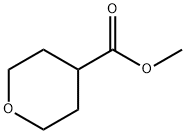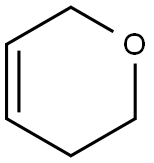4-BROMO-TETRAHYDROPYRAN
Synonym(s):4-Bromooxacyclohexane;4-Bromotetrahydro-2H-pyran
- CAS NO.:25637-16-5
- Empirical Formula: C5H9BrO
- Molecular Weight: 165.03
- MDL number: MFCD07371501
- EINECS: 687-292-9
- SAFETY DATA SHEET (SDS)
- Update Date: 2025-07-24 18:13:45

What is 4-BROMO-TETRAHYDROPYRAN?
Chemical properties
Light yellow liquid
The Uses of 4-BROMO-TETRAHYDROPYRAN
4-Bromo-tetrahydropyran is a useful reactant in organic synthesis.
The Uses of 4-BROMO-TETRAHYDROPYRAN
Reactant for:
- Nickel-catalyzed alkyl-alkyl Suzuki coupling reactions with boron reagents
- Preparation of a selective small-molecule melanocortin-4 receptor agonist with efficacy in a pilot study of sexual dysfunction in humans
- Preparation of aliphatic hydrocarbons via nickel-catalyzed Suzuki cross-coupling with alkylboranes
- Preparation of anthranilic acids as antibacterial agents with human serum albumin binding affinity
- Preparation of antiatherogenic antioxidant di-tert-butyldihydrobenzofuranols via Grignard reactions with di-tert-butyl(hydroxy)benzaldehyde derivatives
- Synthesis of gephyrotoxin via the Schmidt reaction
Properties of 4-BROMO-TETRAHYDROPYRAN
| Boiling point: | 178℃ |
| Density | 1.467 g/cm3 at 25 °C |
| refractive index | n20/D1.497 |
| Flash point: | 69℃ |
| storage temp. | under inert gas (nitrogen or Argon) at 2-8°C |
| form | clear liquid |
| color | Colorless to Yellow to Orange |
| CAS DataBase Reference | 25637-16-5 |
Safety information for 4-BROMO-TETRAHYDROPYRAN
| Signal word | Warning |
| Pictogram(s) |
 Exclamation Mark Irritant GHS07 |
| GHS Hazard Statements |
H315:Skin corrosion/irritation H319:Serious eye damage/eye irritation H335:Specific target organ toxicity, single exposure;Respiratory tract irritation |
| Precautionary Statement Codes |
P261:Avoid breathing dust/fume/gas/mist/vapours/spray. P264:Wash hands thoroughly after handling. P264:Wash skin thouroughly after handling. P271:Use only outdoors or in a well-ventilated area. P280:Wear protective gloves/protective clothing/eye protection/face protection. P302+P352:IF ON SKIN: wash with plenty of soap and water. P305+P351+P338:IF IN EYES: Rinse cautiously with water for several minutes. Remove contact lenses, if present and easy to do. Continuerinsing. |
Computed Descriptors for 4-BROMO-TETRAHYDROPYRAN
| InChIKey | IVBVKTPDEWDNRW-UHFFFAOYSA-N |
4-BROMO-TETRAHYDROPYRAN manufacturer
BTC pharm India
4Y
Phone:+91-8790379245
Whatsapp: +91- 6361382515
product: 4-BROMO-TETRAHYDROPYRAN 25637-16-5 98+
SAKEM LLP
1Y
Phone:+91-9676889998
Whatsapp: +91-9676889998
product: 25637-16-5 4-Bromotetrahydropyran 98%
New Products
Indole Methyl Resin tert-butyl 9-methoxy-3-azaspiro[5.5]undecane-3-carboxylate Boc-His(Boc)-OH 2-CTC Resin 4-Chloro-7-tosy1-7Hpyrrolo[2,3-d]pyrimidine 5,7-Dibromo-1H-indole 2,5-dichloro-N-hydroxy-4,6-dimethylpyridine-3-carboximidamide 2,2-Dimethoxy-7-azaspiro[3.5]nonane hydrochloride 4-chloromethyl-5-methyl-1,3-dioxol-2-one (DMDO-Cl) R-2-BENZYLOXY PROPIONIC ACID 1,1’-CARBONYLDIIMIDAZOLE 1,1’-CARBONYLDI (1,2-4 TRIAZOLE) N-METHYL INDAZOLE-3-CARBOXYLIC ACID 4-((2-hydroxyethyl)thio)benzoic acid 1-(TERT-BUTOXYCARBONYL)-2-PYRROLIDINONE Methyl 6-methylnicotinate 3-Pyridineacrylic acid tert-Butyl carbazate TETRAHYDRO-2H-PYRAN-3-OL 2-((4-morpholinophenylamino) (methylthio) methylene) malononitrile 3-(4-morpholinophenylamino)-5-amino-1H-pyrazole-4-carbonitrile 2,4-dihydroxybenzaldehyde 1,3-Diethyl-1,3-Diphenylurea Methyl 2-methylquinoline-6-carboxylateRelated products of tetrahydrofuran








You may like
-
 4-Bromotetrahydro-2H-pyran CAS 25637-16-5View Details
4-Bromotetrahydro-2H-pyran CAS 25637-16-5View Details
25637-16-5 -
 4-Bromotetrahydropyran CAS 25637-16-5View Details
4-Bromotetrahydropyran CAS 25637-16-5View Details
25637-16-5 -
 25637-16-5 4-Bromotetrahydropyran 98%View Details
25637-16-5 4-Bromotetrahydropyran 98%View Details
25637-16-5 -
 4-BROMO-TETRAHYDROPYRAN 25637-16-5 98+View Details
4-BROMO-TETRAHYDROPYRAN 25637-16-5 98+View Details
25637-16-5 -
 Pyridine 99.5% HPLC /UV SpectroscopyView Details
Pyridine 99.5% HPLC /UV SpectroscopyView Details
110-86-1 -
 Dibutyl PhthalateView Details
Dibutyl PhthalateView Details
84-74-2 -
 Imidazole Spot supply, competitive priceView Details
Imidazole Spot supply, competitive priceView Details
288-32-4 -
 Thiourea 99% ARView Details
Thiourea 99% ARView Details
62-56-6
Statement: All products displayed on this website are only used for non medical purposes such as industrial applications or scientific research, and cannot be used for clinical diagnosis or treatment of humans or animals. They are not medicinal or edible.
